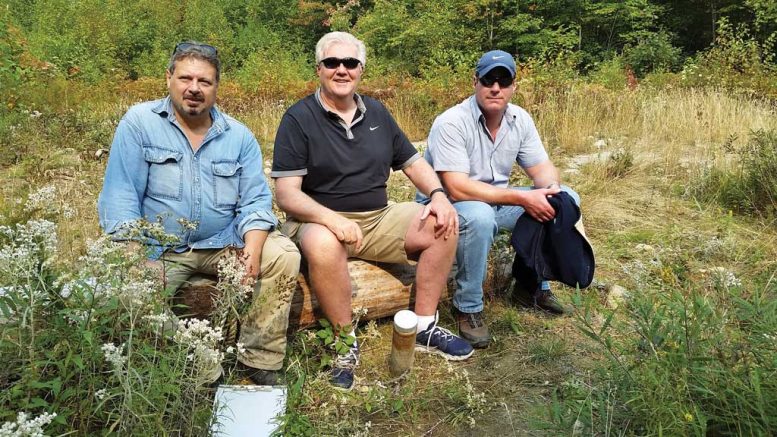New Age Metals (TSXV: NAM; US-OTC: PAWEF) is probably best known for its River Valley project near Sudbury in northwestern Ontario, now the largest undeveloped platinum group metals (PGM) project in Canada, with an estimated 2.5 million oz. near-surface PGMs and gold.
But two years ago the company set up a lithium division after its founder, chairman and CEO Harry Barr, met Carey Galeschuk, a geologist living in Manitoba.
Galeschuk had spent 12 years as an exploration geologist for Tantalum Mining Corp. (owned by Cabot Corp.) at its Tanco spodumene-tantalum-cesium mine, 180 km northeast of Winnipeg.
The mine was built in the late 1960s to produce industrial minerals from the giant Tanco pegmatite in the Winnipeg River pegmatite field near the Manitoba-Ontario border. The Tanco pegmatite was discovered during a drilling program exploring for tin in the late 1920s.
Between 1986 and 2009, the underground mine produced spodumene concentrate, much of it sold to manufacturers in the U.S. that used it to make glass-ceramic cookware known as VisionWare and CorningWare. (Spodumene, a lithium-bearing mineral found in pegmatite dikes, can be used as a feedstock for producing lithium carbonate and metal, or directly in its mineral form, in the glass and ceramics industries.)
The mine also produced tantalum concentrate in varying capacities from 1969 until 2009. Tanco only extracts cesium from pollucite, which it uses to make cesium formate, a drilling fluid in the petroleum industry.
There are no National Instrument 43-101 compliant resources available for the Tanco pegmatite, according to New Age Metals, but academic publications have estimated the size of the deposit reaches up to 57 million tonnes. The last non-compliant reserve from the Tanco pegmatite, published in 1992, estimated the giant pegmatite contained 1.08 million tonnes grading 0.12% tantalum oxide, 3.5 million tonnes of 2.7% lithium oxide (Li2O) and 315,000 tonnes of 23.3% cesium oxide.
In a meeting in Toronto in February 2016, Galeschuk told Barr that while he had worked in exploration for the Tanco mine, the company was interested in finding tantalum-rich pegmatites rather than lithium-rich pegmatites, and said New Age Metals should stake ground around the Tanco mine and acquire more property in the area.

At the exploration camp on New Age Metals’ River Valley PGM property near Sudbury, Ont., from left: Mike Neumann, director; Harry Barr, chairman and CEO; Trevor Richardson, president and chief operating officer; Susan Mitchell, advisor; and Todd McCracken, consultant. Photo by Trish Saywell.
Between April and November 2016, New Age Metals did just that, becoming the largest claim holder in the Winnipeg River Pegmatite Field, acquiring through staking and optioning five hard-rock lithium projects near or next to the Tanco mine leases, 125 km northeast of Winnipeg, Manitoba.
The Lithium One and Lithium Two Projects have known pegmatites that New Age Metals sampled in 2016. The other projects are the Lithman East, Lithman North and Lithman West. Three of the five projects are considered drill ready.
Lithium One, 8.5 km southeast of the Tanco mine, has at least 40 known surface pegmatites of various dimensions and compositions, many of them lithium-bearing. The Silverleaf pegmatite, for example, is a zoned complex lithium-bearing pegmatite with a surface exposure of 80 metres by 45 metres. Samples taken from Silverleaf’s Lepidolite-Spodumene zone have returned assays from 1.30% to 2.43% Li2O.
The zone is 50 metres by 20 metres and extends into a historic, excavated open pit, which dates to the late 1920s, when a bulk sample of spodumene was mined from the southwest side of the pegmatite. A sample from the historically mined spodumene rock pile returned values of up to 4.33% Li2O.

Field equipment at New Age Metals’ Lithium Two project. Credit: New Age Metals.
Lithium Two, 22 km north of the Tanco mine, has two known pegmatites exposed at surface: Eagle and FD 5. Eagle is a series of lenticular, spodumene-bearing dikes over an exposed distance of 830 metres. Drilling in 1947 resulted in a historic, non-compliant estimate of 544,000 tonnes of spodumene with an average grade of 1.4% Li2O. Eagle remains open at depth, and surface samples New Age Metals has taken in fieldwork have yielded assays of up to 3.04% Li2O.
The FD 5 pegmatite is exposed over an area of 15 metres and has not been previously drilled. The best surface assay was 2.08% Li2O over a 1.5-metre chip sample.
Lithman East and West are next to the Tanco mine leases (Lithman West used to be part of the Tanco claims), while Lithman North sits 15 km northeast of the mine leases. There are no exposed pegmatites on Lithium West but there are a lot of geochemical targets for pegmatites, while Lithman East and North have numerous pegmatites that have yet to be fully evaluated.
Barr notes that New Age Metals has more claims for lithium in the area, with over 600 sq. km, than any other company, although several other juniors have moved into the area since it acquired its properties there.
“The Tanco mine is owned by Cabot Corp., but, generally, few people know about it,” Barr says in an interview from Vancouver. “You can be in a room of educated mining geologists, engineers and stock brokers, and only three out of 10 would be able to put their hands up and say that they’d heard about the Tanco mine and pegmatite field that we’re in and the fact that Cabot owns it, and has been producing there since 1969. It’s just amazing.”
In another interview, Galeschuk, who lives 100 km from the Tanco mine and says he “knows the area like the back of my hand,” says that like kimberlites — which need to be found and tested extensively to see whether they contain diamonds in enough quantity and quality to be economic — pegmatites must be found and then tested thoroughly to see if they contain “the good stuff.”
Pegmatites are felsic systems and are similar in composition to a granite in the sense that they can contain feldspar, quartz and mica, Galeschuk says, and they need to be derived from certain types of granites. The best pegmatites are more “evolved,” or fractionated.

Prospector Robert Freeman sampling in 2016 at New Age Metals’ Lithium One lithium property in Manitoba. The sample bag sits on an outcrop of the Spodumene-Lepidiolite Zone. Photo by Carey Galeschuk.
When he worked for Tanco, Galescuk did surface exploration, soil and rock geochemistry, and drilled some pegmatites. “The pegmatites we found were mainly tested for tantalum and rarely for lithium,” he says. “The mine was interested in tantalum-bearing pegmatites”
Galeschuk also notes that the Tanco pegmatite does not outcrop, and much of it is under Bernic Lake.
“There could be another Tanco out there — that’s what we were exploring for when I was at the Tanco mine,” he says. “Tanco would never have had interest in a small one, or one that was spodumene-rich.”
The Tanco pegmatite belongs to the Bernic Lake pegmatite group, part of the Cat Lake-Winnipeg River pegmatite district. The district is in the Bird River greenstone belt, which is part of the Archean Superior Province.
“At the time there really were only a handful of us in the world that were exploring for pegmatites,” Galeschuk says about Tanco, “but now everyone is looking at pegmatites.”
In January, New Age Metals completed an option agreement on the five projects with Azincourt Energy (TSXV: AAZ).
Under the agreement, Azincourt can acquire full interest in stages. Azincourt has paid New Age Metals $10,000 and can acquire a 50% interest for $200,000 in cash — paid over 18 months — and up to 1 million shares, paid over three years. Azincourt would spend $2.1 million on exploration over three years.
Azincourt can increase its stake to 60% by paying another 1 million shares and spending $750,000 by October 2021. At that point, New Age Metals can form a joint venture. If it doesn’t, Azincourt can boost its stake to 100% by paying another 1 million shares and spending another $1 million on the project by October 2022. New Age Metals would retain a 2% net smelter return royalty on all five projects.
A minimum of $500,000 will be spent on exploration this year.
“There’s more work to be done,” Barr says. “We’re going to go out and do a big round of field sampling on numerous different targets that haven’t been touched since the 1950s, and we’ll drill in July, August and September.”





Be the first to comment on "New Age options Manitoba projects to Azincourt"